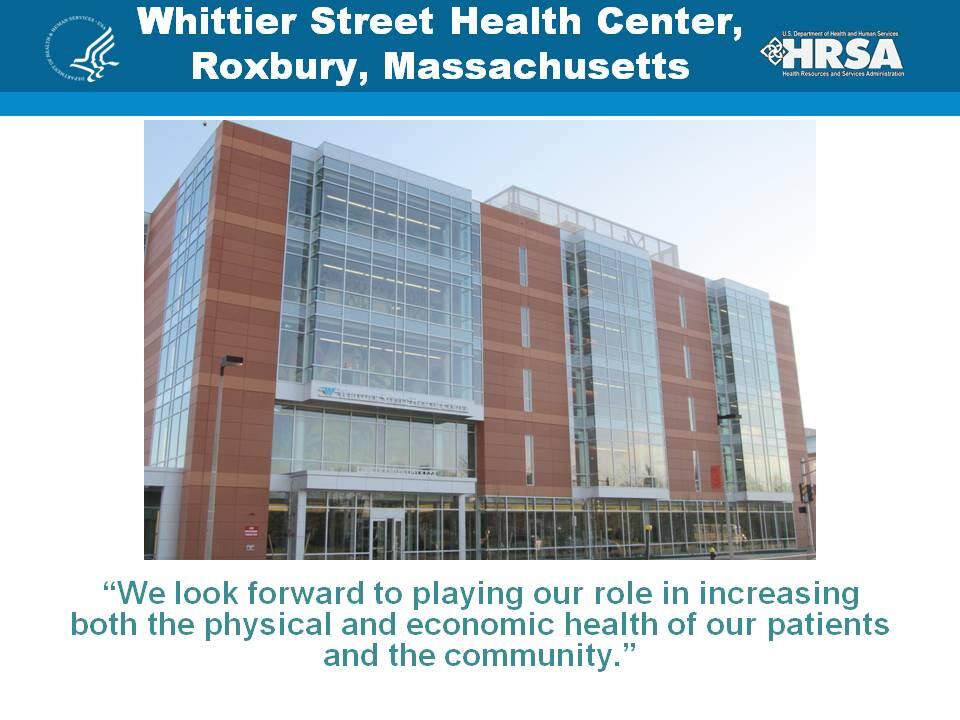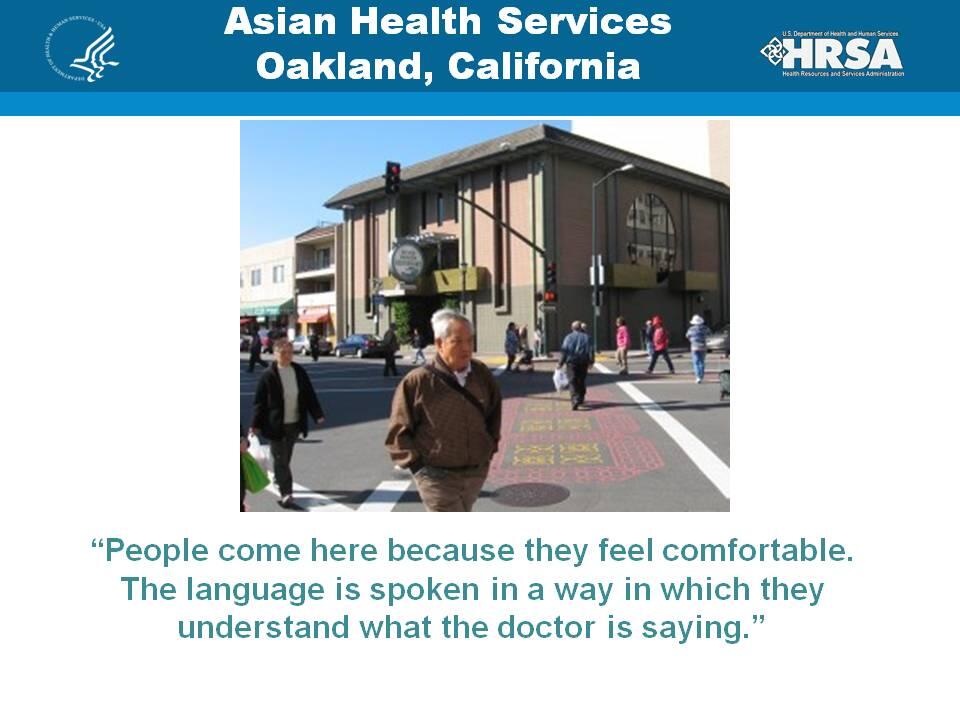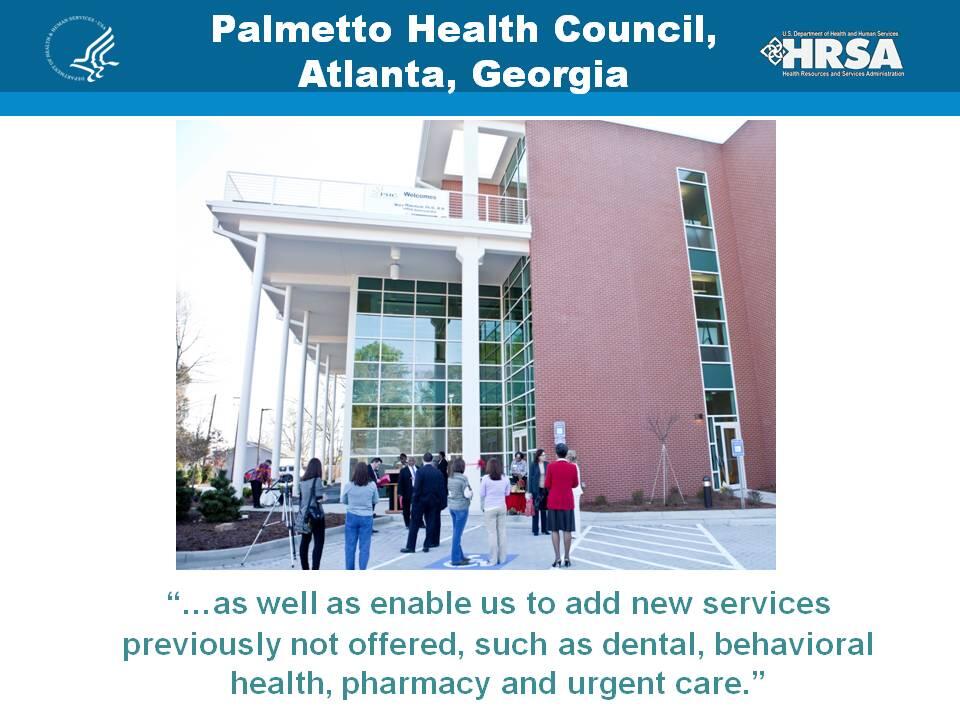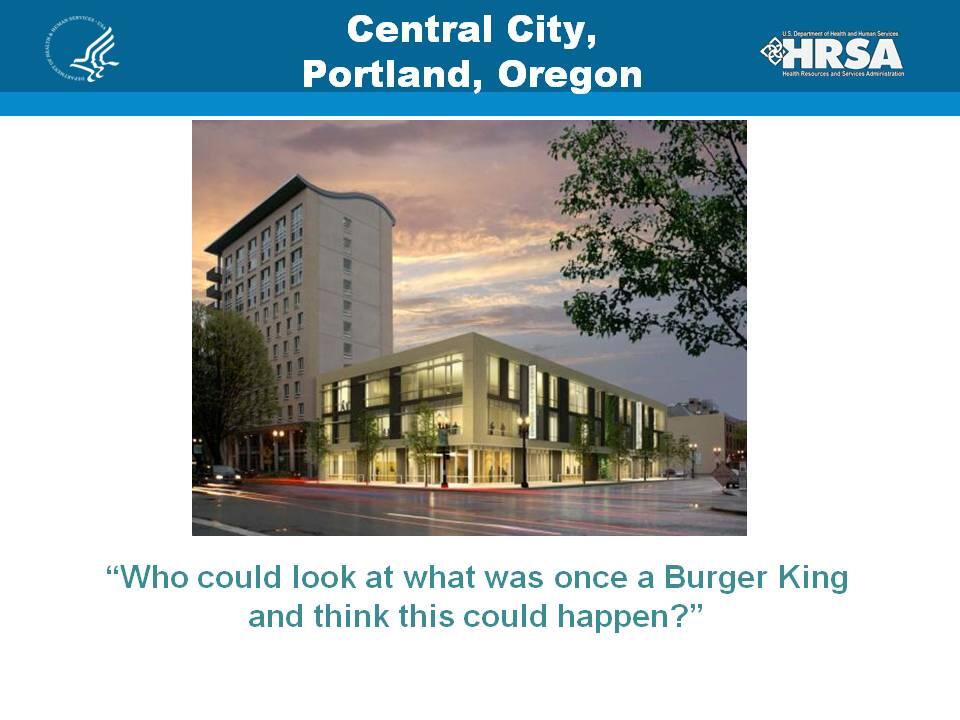
U.S. Department of Health & Human Services
Health Resources and Services Administration
HRSA Press Office: (301) 443-3376
by HRSA Administrator Mary K. Wakefield, PhD, RN
March 23, 2012
Washington, D.C.
Good morning.
It is a pleasure to be here with you again to address your annual conference. A special hello to my friends from North Dakota – and I also want to acknowledge the HRSA staff that are here with me today. It’s a privilege for me to work with such a smart and high-energy team – will you all please stand? I couldn’t ask for better colleagues than Jim (Macrae) and his team. You have some of the best of the best working with you.
I want to begin by offering my deepest thanks to each of you for the tremendous amount of great work you’ve done in the last two years, following the enactment of the historic Affordable Care Act. Together with the Recovery Act before it, the ACA – and today marks its 2nd anniversary – is already contributing substantive improvements to health and health care across the nation.
From HRSA’s perspective – and I know from yours as well -- the Affordable Care Act has clearly underscored the value of health centers and their role in delivering top-quality primary and preventive care to the people who need it most. In 2010 alone, 7.4 million uninsured individuals and more than 9 million Medicaid, CHIP and Medicare beneficiaries were served by health centers. I imagine that few Americans really know what a tremendous contribution that is, and that you’re making, to the well-being of our nation. But they should know it and, believe me, I certainly tell everyone I talk to. As a partner with you, your work is a particular source of pride to us at HRSA.
As grantees, you work directly with the team at our Bureau of Primary Health Care headed by Jim Macrae. But your activities also draw on other human and financial resources across HRSA and your work at the local level impacts the work of virtually all of HRSA’s other bureaus and offices.
One of my aims as HRSA administrator has been to encourage us as an agency and all of HRSA’s grantees – including health centers -- to work together in partnerships with other grantees and with other state and federal programs whenever and wherever it benefits the interests of those involved. I’ll discuss how that’s happening at HRSA bit later.
But first I want to begin by highlighting the importance of the Affordable Care Act to your work and to the health of the American people.
As you know, the ACA will not be fully in place until the end of 2014, but even now the law is touching people in your communities and improving their lives. More Americans every day are gaining access to care because of the Affordable Care Act, and many of them are already crowding into your centers for service.
Since the beginning of 2009, health centers have increased the total number of patients served annually by 2.4 million, from 17.1 million to 19.5 million. And you can count on more growth as we work to fully implement the law through 2014. The President’s 2013 proposal projects that your centers, collectively, will serve an estimated 21 million patients.
Here’s just a small snapshot of how Americans benefit from the ACA – and a picture of the future demand for the care your health centers provide:
- To date, some 86 million Americans have taken advantage of the ACA’s preventive health services and screenings, now available at no cost to patients. As a nurse, I know all of you understand full well the difference we can make by focusing on building a system that really keeps people healthy and prevents illness from taking root.
- Also as a result of the ACA, 2.5 million young adults nationwide now have health insurance thanks to the law’s provision that allows dependents to remain on their parents’ health insurance plans until age 26. That’s some peace of mind for these young people and perhaps a lot of peace of mind for their parents.
- And nearly 50,000 people with pre-existing conditions that needed health insurance the most but were unable to get it or afford it now have health insurance thanks to the law’s Pre-Existing Condition Insurance Plan program. In 2014, insurers will be prohibited from denying coverage to any American with a pre-existing condition. Until then, the PCIP program continues to provide enrollees with affordable insurance coverage.
And while the ACA is expanding Americans’ access to care, it also markedly diminishes the day-to-day stress that individuals and families have had to carry as more and more of us are relieved from the anxiety over where to find care and how to pay for it.
- For example, the law lifts lifetime caps on insurance benefits, and that frees people with diseases that require costly therapies from a particularly heavy emotional and financial burden.
- And for millions of seniors with fixed incomes and high medication costs, they are already saving an average of about $600 each on needed drugs, freeing some of them from the anguish of deciding whether to pay for medications or food.
- And more Americans will be free to stay in a job they love instead of feeling forced to take the one that offers health insurance. The ACA’s tax breaks for small business owners helps them offer health insurance coverage to trusted employees.
And even with all of this already underway, the law, of course, does much more.
To improve care quality, the ACA strongly emphasizes coordinating the care that patients receive. In care coordination, health centers are leading the way by embracing Patient-Centered Medical Homes as a model for quality improvement.
More and more, health center patients are cared for in these medical, or health homes. Increasingly, health centers offer one-stop shopping. It’s your center where patients can go to get most of what they need – medical care, dental care, and behavioral health care.
Consider a few examples of the array of services you provide: Already health centers provide prenatal care to a half-million expectant mothers every year – 67 percent of them in the first trimester – while tending to 178,000 births.
You also immunize 233,000 kids under the age of 2; administer lead tests to 300,000; manage 540,000 cases of asthma; and provide early-detection screening that identifies 775,000 children per year who have hearing, developmental or other disorders and conditions.
HRSA also looks forward to our continued work with you to identify opportunities for health centers everywhere to achieve formal recognition as PCMHs. HRSA’s goal is that a quarter of health centers be recognized as PCMHs by the end of next year.
And at the level of the entire U.S. Department of Health and Human Services, this goal is one of only six high priority Departmental goals and it demonstrates the importance of the work being done in health centers.
The other five high-priority goals for HHS are:
- To improve patient safety by reducing the national rates of hospital-acquired central line-associated bloodstream infections and catheter-associated urinary tract infections;
- To improve the use of health information technology, increasing the number of providers who receive Medicare and Medicaid Electronic Health Records incentive payments;
- To improve the quality of early childhood care and education programs for low-income children;
- To reduce adult cigarette smoking consumption; and
- To reduce foodborne illness in the population.
That gives you a sense of some of our HHS-wide priorities and your work to improve primary care quality is among them.
To support the PCMH goal, thanks to FY 2011 ACA funds, HRSA awarded $32 million to 904 health centers to support medical home implementation costs. As of September 2011, 241 health centers have applied to NCQA for PCMH recognition; and the first 48 have all achieved recognition. Congratulations to those health centers! For the others, the recognition process continues, and I certainly encourage you to apply.
HRSA also is working with CMS on the Medicare FQHC Advanced Primary Care Practice demo, which is now readying 500 more sites to enter the NCQA recognition process. These demos focus on increasing the number of Medicare beneficiaries receiving their care at health centers in a patient-centered medical home environment.
In terms of quality outcomes for health centers, I’m aware that care nationally at health centers compares favorably and in several areas exceeds targets set in Healthy People 2020, the federal government’s blueprint for health policy planning.
I know, too, that health center patients report being more satisfied with their care than patients of other providers, and that the cost of the care that you provide is typically lower than in many other health care settings.
But we also all have work to do in this area, and we are committed to working with you – our patients and communities deserve that commitment.
Because while nearly 60 percent of health centers meet or exceed Healthy People goals for control of hypertension and low-birthweight, and more than a third exceed goals for childhood immunizations and entry into prenatal care, we have not been as successful in other important areas – for example, in control of diabetes and cervical cancer screening rates.
And while many health centers are doing well, we need all health centers focused on continuously improving care quality and health outcomes while working to eliminate health disparities for all of their patients.
So I urge you all to help us move the needle, and move it strongly. HRSA stands ready to do whatever we can to transform the quality of care you deliver. Where it’s good, let’s make it better, and where it’s better, let’s make it the best.
Speaking of the best, one of our health centers, Clinica Campesina, was recently highlighted in the New England Journal of Medicine for its exemplary practices and for addressing key issues in primary care practices.
The article asked: “How can continuity of care be made the centerpiece of a medical practice’s ethos? Can a policy of providing prompt access be sustained? Who should be included in care teams, who should perform which work, and how central to team function are colocation, workflows, and standing orders? How should care for common conditions be standardized?”
Frankly, these are questions that each of you could be considering. The article concluded by noting that “Clinica’s leaders have created an organization that serves patients well while retaining a group of loyal clinicians.” That’s a result that quality health care facilities regardless of their type should be aspiring to match.
Of course, as efforts to improve care quality grow, so too does the overall health center network expansion begun by the Recovery Act and strengthened by the ACA’s commitment of $11 billion over five years.
That growth increases health centers’ presence in your home communities and underscores the increasingly vital leadership role you play in the economic vitality of cities, towns and rural areas. And make no mistake, we’re not just building facilities through the ACA expansion, we’re investing in health care leaders, too.
In terms of investing in leaders and heroes of a different type, as you know, the Obama administration challenged health centers to hire 8,000 veterans – approximately one veteran per health center site – over the next three years.
Veterans of the U.S. military have skills and experiences that can work for your health center. Whether it’s as a dentist, nurse, facilities director or scheduling clerk, you can clearly trust and capitalize on the training, experience and discipline of our veterans.
And when veterans put their skills to work at a health center, they continue to be a valued member of a team, a part of the mission to continue serving their country – caring for people who otherwise might be unable to find or afford basic health care.
I am grateful to NACHC for their collaborative efforts in this challenge. Speaking of the health centers’ current leaders, I recently had the pleasure of speaking at ceremonies convened to mark the reopening of the Whittier Street Health Center in Roxbury, Mass. Frederica Williams, president and CEO, put it very well in her remarks when she said:
“We know that health and the economy are inextricably linked – socioeconomic status directly correlates with health and healthier people build a stronger economy … [and] we look forward to playing our role in increasing both the physical and economic health of our patients and the community.”

Or as Sherry Hirota, chief executive officer of Asian Health Services, recently said in Oakland:
“Across the board, it was understood that health centers would be called upon to be the workhorse to expand. People come here because they feel comfortable. The language is spoken in a way in which they understand what the doctor is saying. They understand the medication they’re being prescribed. They understand what they need to do in terms of their own self-care management that will potentially keep them healthier and out of the hospital.”

And I recently visited Palmetto Health Council in Georgia. As CEO Jon Wollenzien Jr., noted:
"This new facility will enable us to expand our capacity to serve a greater number of individuals residing in South Fulton and the surrounding counties as well as enable us to add new services previously not offered, such as dental, behavioral health, pharmacy and urgent care."

As an aside, Palmetto’s new medical facility was built to be designated as a LEED Gold facility. After this designation, PHC will operate the only LEED Gold medical facility in the Southeast. And about that fact, Jon said:
"This is an incredible accomplishment!" We concur!
Finally, as one participant said at the grand opening of a new homeless health center at Central City in Portland Ore. “Who could look at what was once a Burger King and think that this could happen?” Thirteen months later, a radically different building stands in its place.

That’s an amazing transformation. Of both a building and a community.
Across the nation, in your home communities, you’ve made health centers so much more than a place to go for health care – you’ve also made them places for your employees to find stable, well-paid work, a place to launch and sustain a career.
In my travels around the country, I’ve been struck again and again by the feeling that the CEO or administrator or clinician I meet is so dedicated to the mission we share – I really and constantly sense that the right person is working at the right site. When that clicks, and administrators and clinicians stay and build careers, they become integral parts of that community. As a result, they – meaning you – often bring stellar leadership to communities that stand to benefit so much from that vision and energy.
In addition to supporting you in your important work through the Recovery Act and the ACA, HHS has supported the largest capital expansion in community health center history. And we look forward to announcing new ACA capital development award funds in a few weeks.
Regarding funding overall, here’s where we are now in 2012 and where the President’s proposed 2013 budget will take us.
The total appropriation for health centers in FY 2012 – that’s the appropriation combined with mandatory ACA dollars – is about $2.8 billion, or some $185 million above the 2011 level.
During the rest of FY 2012, we expect to announce grants totaling approximately $150 million to establish some 220 new access points. Approximately $15 million or $20 million will support the expansion of health center services. That includes $5 million to support the President’s National HIV/AIDS Strategy in a joint effort with the Ryan White HIV/AIDS program to enhance the care and treatment for individuals living with HIV/AIDS at health centers that are also service providers under Part C of Ryan White. Part C provides comprehensive primary health care in an outpatient setting for people living with HIV disease.
We’ll also award about $20 million to support the adoption of electronic health records and other health information technology systems through health center controlled networks.
In addition, we expect to make an announcement shortly on another School-Based Health Center Capital Program funding opportunity. Already, we’ve awarded more than $100 million to over 300 school-based health center programs – with nearly half of the awardees being community health centers. Those investments, of course, also were made possible by the Affordable Care Act.
To stay on top of the latest ACA news and developments, I strongly urge everyone to bookmark www.healthcare.gov; your colleagues and patients can go there, too – it’s updated in real time. and go there often. It’s a great resource.
Looking ahead to Fiscal Year 2013 that begins October 1 of this year, the President’s budget proposal foresees continued expansion of the health center network. Under current conditions, that is quite an achievement.
The FY 2013 budget was released under very challenging circumstances. These are extremely difficult times, with pressures coming from all sides to reduce the budget deficit.
Consequently, painful funding decisions in some parts of HRSA’s budget would not have been necessary in better times, and they certainly were not made lightly. However, while most federal agencies are receiving significant reductions in next year’s budget proposal, HRSA’s budget has remained essentially flat.
The President’s budget request for HRSA reflects his Administration’s continued focus on:
- strengthening the health care safety net;
- protecting at-risk populations;
- supporting healthy families, and
- ensuring that we have enough primary care clinicians to meet an ever-growing demand for services.
So a budget that promotes a policy of steady and sustainable community health center growth is, as I said, given the current environment, a remarkable achievement. And it reflects President Obama’s knowledge of and appreciation for the vital role that health centers and those that lead them play in your communities.
His 2013 budget would provide $3 billion for health centers. These funds will provide services to an estimated 21 million patients, and add new health center access points.
Earlier I talked about how the various bureaus and offices across HRSA are stepping up their working relationships to integrate services. Let me give you just a few examples.
In terms of HIV/AIDS, over 780,000 health center patients received HIV screenings in 2010 – 40 percent of them in the 12 jurisdictions hardest hit by the virus – and more than 90,000 patients with an HIV diagnosis received care at a health center.
Of our 1,100 health center grantees, 160 are now participating in HRSA’s Ryan White Part C program I mentioned a moment ago, and 24 others in more than a dozen states are taking part in capacity-building programs through the new National Center for HIV Care in Minority Communities. This group of health centers already serves almost 1,800 HIV-positive patients without the benefit of Ryan White funding.
That’s why we were so pleased that in observance of the 2011 World AIDS Day, President Obama announced the availability of $50 million in additional funds for AIDS Drug Assistance Programs and to increase access to HIV/AIDS care and treatment. These activities support the implementation of the President’s National HIV/AIDS Strategy, a national framework for combating the HIV/AIDS epidemic in the United States. The National Strategy has four overarching goals:
- Reduce the number of people who become infected with HIV;
- Increase access to care and optimize health outcomes for people living with HIV;
- Reduce HIV-related health disparities; and
- Achieve a more coordinated national response to the HIV epidemic.
To support the National Strategy, HRSA will soon announce an Increasing Access to HIV Care and Treatment supplemental funding opportunity for FY 2012. This announcement is a joint effort by HRSA’s HIV/AIDS Bureau and the Bureau of Primary Health Care. Eligible applicants include HAB’s Ryan White Part C grantees and Health Center grantees that receive Ryan White Part C funds.
Many health centers, it should be noted, are members of the National Coalition for LGBT Health – and some actually began as LGBT clinics. Of these members, I want to congratulate The AIDS Foundation of Chicago and Philadelphia’s Mazzoni Center for joining a group of 129 organizations nationwide that received $10 million in planning grants this year to help them become health centers.
HRSA also has awarded $248,000 to Boston’s Fenway Health to create a national LGBT technical assistance and training center for health centers and state primary care associations. This is the first time that HRSA has entered into a national cooperative agreement focusing on LGBT health, and it’s the largest HRSA grant ever awarded to target the health care needs of LGBT people.
Earlier, I mentioned the vital role health centers play in providing high-quality jobs and stable careers for local residents. In 2010, health centers employed more than 131,000 staff, including nurses, physicians, behavioral health staff, case managers and health education, outreach, and transportation staff.
Since the beginning of 2009, health centers have added more than 18,600 new full-time positions in many of the nation’s most economically distressed communities.
We know workforce is critical to health centers and the FY 2012 budget supports efforts begun by President Obama to build an adequate health workforce through an $867 million investment on building capacity and placing providers where they’re needed most. The President proposes to invest $677 million to increase the number and improve the distribution of primary care and pediatric providers. This will ensure that qualified clinicians will continue to be available to staff Health Centers in particular.
In addition, the field strength of the National Health Service Corps (NHSC) is projected to increase to more than 7,000 clinicians by 2013. This is an expansion from just 3,600 Corps members when the Obama Administration took office.
Health centers also, of course, are a key part of the rural health care safety net. In FY 2011, HRSA awarded millions in ACA funds to health centers serving rural populations.
Building on these investments, the President's 2013 budget proposal also includes $122 million to improve both access to and the quality of health care in rural areas. The President’s budget again includes funds to support the Improving Rural Health Care Initiative. This sustains HRSA's core rural health programs and supports key activities such as the identification of best practices, workforce recruitment and retention, telehealth and HIT coordination, and collaboration across governments.
In closing, let me tell you how proud HRSA is to be your partner and to share a mission with you that focuses on improving health and achieving health equity through access to quality services.
And now, over a period of decades, your determination to improve the lives of low-income people who for too long lacked access to essential health care services – including oral health and behavioral health services – has inspired many across the country.
And your dedication to service has earned the admiration and broad-based support of Congressional leaders and Presidents from both parties. You might ask: How many federally supported public health programs can say the same?
Health Centers provide health services to people who otherwise might well be without them. So, during your existence, you have truly made a difference in millions of lives, and I can’t imagine a better legacy.
Thank you so much for all that you do. Thank you.










